|
|
|
Sort Order |
|
|
|
Items / Page
|
|
|
|
|
|
|
| Srl | Item |
| 1 |
ID:
124738
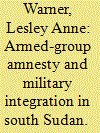

|
|
|
|
|
| Publication |
2013.
|
| Summary/Abstract |
Since the signing of the Comprehensive Peace Agreement in 2005, the government of South Sudan has sought to neutralise the threat that armed groups pose to stability through their integration into the Sudan People's Liberation Army (SPLA), rather than coercion. Although successful in part, this approach has nevertheless led to the continued proliferation of armed groups. In this article, Lesley Anne Warner analyses how the government of South Sudan and the SPLA have administered the amnesty and integration process, concluding that military integration is a process that is managed, but not yet fully mastered.
|
|
|
|
|
|
|
|
|
|
|
|
|
|
|
|
| 2 |
ID:
124231
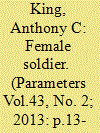

|
|
|
|
|
| Publication |
2013.
|
| Summary/Abstract |
Since the 1970s, women have been increasingly integrated into the military; in Iraq and Afghanistan many women served on the frontline in combat. This article argues women's integration has been facilitated by the all-volunteer professional forces in which individuals are judged purely by competence. Female soldiers have been accepted in all military roles if they perform competently. There are serious limitations in the infantry, however, as only a small number of women pass the selection tests and it is likely no more than one percent of the infantry could be female at present. Moreover, masculine prejudices abound and women are still the victims of discrimination, harassment, and abuse.
|
|
|
|
|
|
|
|
|
|
|
|
|
|
|
|
| 3 |
ID:
175825
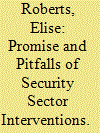

|
|
|
|
|
| Summary/Abstract |
Development practitioners and scholars have touted security sector reform (SSR) in Sierra Leone as a model for intervention. Twenty years after such reforms began, the West African country presents one with the opportunity to study the medium-term impact of SSR. This article argues that specialists should consider this SSR along five dimensions: security institution building, military reform and integration, internal security reform, professionalization, and disarmament, demobilization, and reintegration. This study further explores the impact these factors have had on security performance and legitimacy in the two decades since their implementation. Finally, this work concludes with an analysis of the current state of the security sector as well as a consideration of the lessons to be learned from the Sierra Leonean experience.
|
|
|
|
|
|
|
|
|
|
|
|
|
|
|
|
| 4 |
ID:
181161


|
|
|
|
|
| Summary/Abstract |
Policymakers and peacebuilding research often focus on rebel groups when studying demobilization and integration processes, but post-war governments must also manage the non-state militias that helped them gain or maintain power. Why do some post-war governments disintegrate their militia allies, while others integrate them into the military? We argue that when a salient ethnic difference exists between the (new) ruling elite and an allied militia, a process of mutual uncertainty in the post-war period will incentivize governments to disintegrate the group. However, governments will be most likely to integrate their militias when the military has sufficient coercive capabilities but few organizational hindrances to re-organizing. Using new data on the post-war fates of victorious militias across all civil conflicts from 1989 to 2014, we find robust support for these claims. The results suggest that a government’s optimal militia management strategy is shaped by both social and organizational constraints during the post-war period.
|
|
|
|
|
|
|
|
|
|
|
|
|
|
|
|
| 5 |
ID:
143223
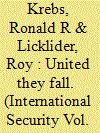

|
|
|
|
|
| Summary/Abstract |
Preventing the recurrence of civil war has become a critical problem for both scholarship and policy. Conventional wisdom urges the creation of capable, legitimate, and inclusive postwar states to reduce the risk of relapse into civil war, and international peacebuilders have often encouraged the formation of a new national army that would include members of the war's opposing sides. However, both the theoretical logics and the empirical record identifying military integration as a significant contributor to durable post–civil war peace are weak. An analysis of eleven cases finds little evidence that military integration played a substantial causal role in preventing the return to civil war. Military integration does not usually send a costly signal of the parties’ commitment to peace, provide communal security, employ many possible spoilers, or act as a powerful symbol of a unified nation. It is therefore both unwise and unethical for the international community to press military integration on reluctant local forces.
|
|
|
|
|
|
|
|
|
|
|
|
|
|
|
|
| 6 |
ID:
177067
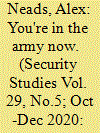

|
|
|
|
|
| Summary/Abstract |
Military integration is intended to facilitate postconflict stabilization by creating unified armed forces from formerly antagonistic armed groups. However, integrated armies often struggle to overcome the factional identities of their soldiers, raising questions about interventionists’ ability to produce military cohesion during such processes. Yet, in the established scholarship on military cohesion, largely derived from the study of Western armed forces, internal small-group social dynamics are privileged over and above broader societal and political identities. This article examines the postconflict military integration program conducted in Sierra Leone to test extant theories of military “social cohesion.” Contrary to theoretical expectations, military cohesion in Sierra Leone proved highly reliant on wider (and highly politicized) societal identities, undermining integration efforts. This finding not only challenges existing understandings of social cohesion and its determinants but also the utility of military integration as a vehicle for postconflict stabilization and civil-military change.
|
|
|
|
|
|
|
|
|
|
|
|
|
|
|
|
|
|
|
|
|